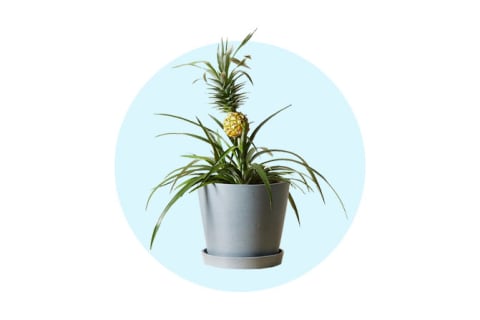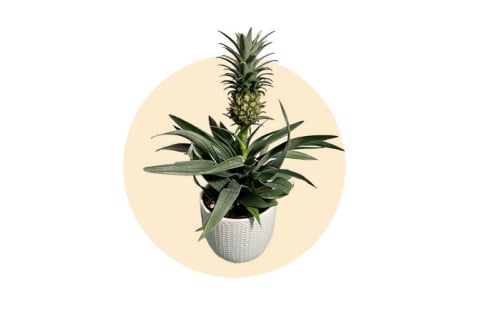Advertisement
Pineapple Plant Guide: Everything You Need To Know To Grow The Tropical Fruit At Home

Curious about whether it's possible to cultivate a juicy pineapple from the comfort of your own home? Despite being a tropical fruit, pineapples can be grown indoors too, just as long as they're given the right conditions. Here's what you need to know to grow and care for your own pineapple plant at home.
What is a pineapple plant?
Pineapples are tropical fruits that likely conjure images of plantations in the Hawaiian islands or other tropical countries. Native to the Americas, these fruits are part of the bromeliad family. There are around three dozen varieties of pineapples, but you'll usually find less than a handful in the produce section.
Although these plants tend to be choosy about conditions, they can be grown indoors as long as they get plenty of sunlight, heat, and quality soil. You can either buy a pineapple plant or propagate your own using the top of a store-bought pineapple.
Types of pineapple plants:
- Abacaxi: Well-known for being one of the most delectable varieties of pineapple, abacaxi has a light, whitish flesh. Since it doesn't transport well, you're unlikely to find it on supermarket shelves—but it's nice for home growing.
- Smooth Cayenne: Known for its sweet fruit, this is a variety that you'll often find in grocery stores. It's also typically used for canning.
- Queen, or "Common Rough": A small dwarf pineapple that can handle colder temperatures, the Queen produces a dark yellow fruit that's fantastic to eat fresh.
Planting & growing your own pineapple plant.
Curious about how to plant your own pineapple? The next time you bring home a fresh, ripe one from the store, don't throw its spiky top in the compost bin. Instead, follow these propagation steps:
- Twist the crown of the pineapple away from the rest of the fruit. It should twist right off with some force.
- Remove a few of the bottom leaves of the pineapple to expose its stem. You should see root buds—small brownish bumps—on the bottom of the stem. With time, new roots should emerge from there!
- Let your pineapple stem dry for a couple of days so it can form a callus. This will reduce the possibility of rotting and fungal infection.
- Place the stem in a small glass of water. Put the glass in a spot in your home that gets bright, indirect sunlight and give it fresh water every 1 to 2 days.
- Typically, it will take 6 to 8 weeks for new roots to take hold. Once you see 1 to 2 inches of light, tiny roots emerging from the bottom of the stem, you can place the pineapple top into a container filled with high-quality potting soil (more on that below). Bury the plant up to its leaves.
- Water the soil and set your pineapple in a warm area of your home that gets direct sunlight. From there, all that's left to do is tend to your plant using the care tips below—and wait for fruit to emerge!
Caring for the plant.
Once your plant is in place, here's how to care for it so it eventually bears fruit.
Soil:
The type of soil you use directly influences the health and success of your growing pineapple plant. "They need well-drained soil such as sandy loam because the sand allows for rapid water movement through the soil," says Marjory Wildcraft, gardening expert and founder of The Grow Network.
Choosing a soil that has plenty of organic matter is also important. "The organic matter provides nutrients for the plant, and good drainage prevents the roots from rotting," explains Lindsey Hyland, gardening expert and founder of Urban Organic Yield.
Ideally, look for potting soil that contains compost or peat moss.
Water:
Pineapple plants need to be watered regularly, but where they are grown will influence how much water they need. "The amount of water needed for a pineapple plant varies wildly depending on the climate," explains Wildcraft. "Generally, pineapples can thrive in dry environments, so less water is better than too much."
So how often should you water your pineapple plant? Tripp and Carmen Eldridge, small-scale farming and gardening experts who currently manage a 5-acre farm at Arden, suggest watering the soil once a week and misting the leaves occasionally to maintain proper humidity conditions.
A rule of thumb is to let the soil dry out before giving your plant another drink of water. Get in the rhythm of checking in on its soil every three days or so.
Sunlight:
Because pineapple plants are native to tropical climates, they need plenty of direct sun and warmth. "Pineapple plants love sunshine. They can take full sun when mature and grow outside in hot climates," says George Tandt, gardening expert and founder of Teak and Terracotta.
"If you're growing inside, make sure to place your container in a spot where it's exposed to sunlight for at least six hours per day," the Eldridges suggest.
Temperature:
Unsurprisingly, tropical pineapple plants grow best in warm and humid conditions. "The best temperatures for pineapple plant growth are between 68°F and 86°F," says Wildcraft. "Never subject your pineapple to freezing temperatures!"
This means placing your plant far away from any drafty windows, air conditioning units, vents, etc.
Fertilizer:
Your pineapple can benefit from additional plant food every now and again, too. "Fertilize the plant once a month with a balanced fertilizer," says Hyland.
Harvesting.
When you start to see a super-small pineapple growing within your plant's tough leaves, it's super exciting. Unfortunately, it takes a while to get to that point.
"The time between planting pineapples and harvesting ranges between 18 to 24 months," say the Eldridges.
"You'll know when it's almost time to harvest as you'll see a fully formed pineapple on the plant," adds Tandt. "It will start to turn from green to yellow in color." Once at least half of your pineapple is yellow, you're good to go.
When it comes to how to harvest, you have a couple of options. Either twist the pineapple from its stem, or carefully slice it off the plant with a sharp knife.
“Each plant produces one fruit, and then will die off," explains Tandt. "However, they often produce smaller 'pups' around the main plant, and one of these will often grow up to replace the plant that dies off."
Common pineapple plant problems.
The following issues are relatively common when growing a pineapple plant from home. Here are some expert tips on how to treat them and nurse your plant back to health.
- Brown leaves: Sometimes, the plant will give off signals that can signify different problems and may require some troubleshooting. Brown leaves are one example. "This can be caused by overwatering, underwatering, or pests," explains Hyland. "Some ways to fix brown leaves include watering the plant properly, adding more soil around the base of the plant, and removing the infested leaves." Exposure to excessive sun can also cause brown leaves, explains Hyland, so you might also want to try moving your plant to a slightly less sunny spot.
- Root rot: It can be easy to go overboard by giving your pineapple plant too much water—and it will show you once you do. One indicator of overwatering is yellow or wilting leaves. Unfortunately, overwatering can wreak havoc on the root system. "The biggest killer is root rot, so make sure the plant is in a well-draining medium and you don't water it until the soil has almost totally dried out from the previous watering," cautions Tandt.
- Pests and bugs: Occasionally, pineapple plants can fall victim to a pest attack. "Pests are a common problem with pineapple plants, especially soft-bodied ones like mealybugs or scales," explain the Eldridges. If you see any creepy-crawlies on your plant leaves, they suggest moving it away from any other plants and spraying it down with a mixture of 1 tbsp of biodegradable soap per quart of water. Neem oil would work here too.
- Base (butt) rot: This is a fungal disease that typically occurs around the time of planting. "To prevent it, before planting, remove all yellow fruit flesh from the top of the pineapple, and do not choose a pineapple lid that has physical damage," says Wildcraft. If you do notice your plant has dark brown/black spots, "you can treat the plant with gentle dish soap or store-bought antifungal spray."
Products.
If after all this you're ready to just fast-forward to the fruit, here are some mature pineapple plants that are available for purchase.
Pineapple plants
The bottom line.
And with that, you're ready to try your hand at growing your own pineapple plant. As long as your space gets enough light and heat, you may be able to bite into your own homegrown pineapple one day. It will take a while, but hey, as the Eldridges say, "Patience is your best asset when dealing with pineapples, but it's worth the effort!"


